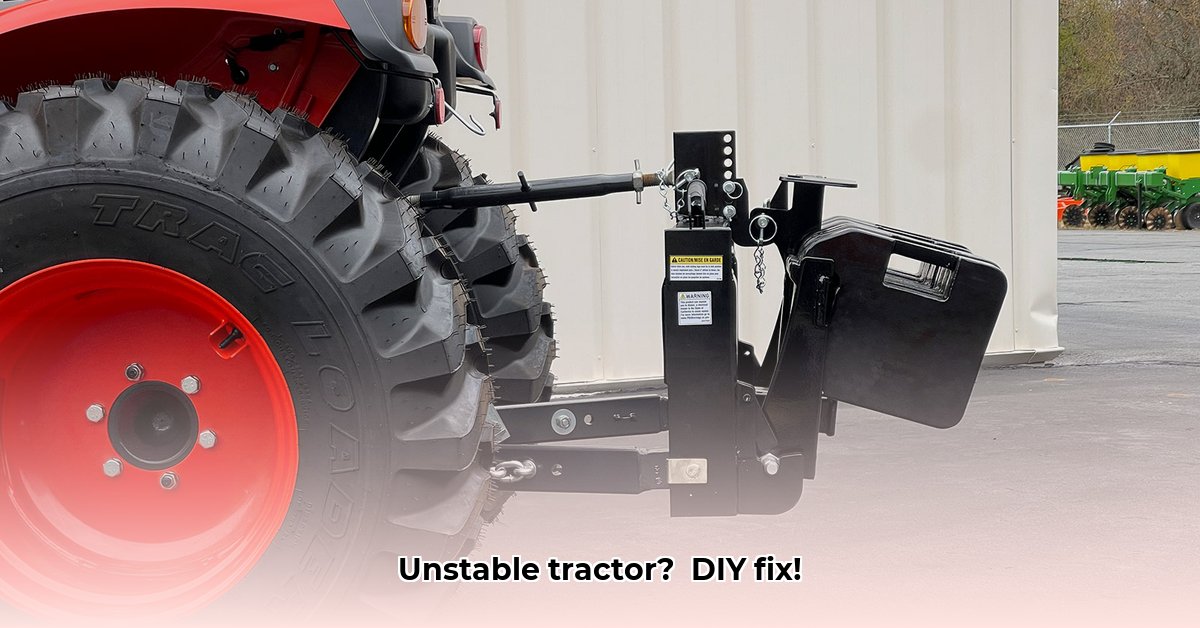
Tractor Counterweight: Boosting Your Compact Tractor's Stability
Feeling that unsettling wobble in your compact tractor, especially when using the front-end loader? This isn't just an inconvenience; it's a serious safety hazard. Improper weight distribution increases the risk of rollovers, particularly on slopes or uneven terrain. Adding a rear counterweight is the simple, effective solution to greatly enhance stability and significantly reduce the risk of accidents. This guide provides practical, DIY methods to boost your tractor's stability. For more on tractor safety, learn about tractor ROPS.
Why is a Rear Counterweight so Important?
Imagine a seesaw. To balance it, you need equal weight on each side. Your compact tractor works similarly. A heavy front-end loader shifts the center of gravity forward, making the rear light and unstable. This imbalance dramatically increases the risk of rollovers – a potentially serious and dangerous situation. A rear counterweight counteracts this imbalance, significantly improving stability and dramatically reducing the risk of tipping. Isn't the safety of you and your equipment worth a small investment of time and effort?
Methods for Adding a Counterweight to Your Tractor
Several effective and affordable DIY methods can add crucial weight to your tractor’s rear.
1. The "Filled Barrel" Method: A Budget-Friendly Approach
- Pros: Extremely inexpensive; readily available materials; easily manageable weekend project.
- Cons: Requires more manual labor than purchasing pre-made weights; the aesthetic result might not be impressive.
Instructions:
- Choose Your Barrels: Select sturdy 55-gallon plastic or steel barrels. Plastic offers rust resistance. Barrel size should allow comfortable placement on your tractor without obstructing operation.
- Mix Your Concrete: A common starting point is a 1:2:3 mix of cement, sand, and gravel. Adjust ratios based on desired strength and setting time. Consult a local building supply expert for specific advice.
- Fill and Compress: Pour the concrete mix into the barrels. Use a long, sturdy object to thoroughly tamp down the mix, eliminating air pockets for maximum compaction. This strengthens the barrel and prevents settling.
- Securely Mount: After the concrete cures (at least 24 hours; longer is better), securely attach the filled barrels to your tractor's rear using heavy-duty chains or strong brackets. Ensure everything is firmly attached.
2. Suitcase Weights: The Convenient Option
- Pros: Specifically designed for tractors; straightforward installation; durable and weather-resistant.
- Cons: More expensive than the DIY barrel method.
Instructions:
- Weight Selection: Choose weights appropriate for your tractor's specifications and intended use. Consult your tractor's manual for weight limits and recommendations.
- Installation: Attach the weights using the manufacturer's recommended mounting hardware. Double-check everything is secure before operation.
3. Using a Backhoe as a Counterweight: A Unique Approach
- Pros: Utilizes an existing attachment; provides significant rear weight.
- Cons: Reduces tractor maneuverability; potential for backhoe damage if not handled carefully.
Caution: This method requires a thorough understanding of its impact on tractor stability and handling. It may not be suitable for all tractors or tasks. Consult your tractor's manual and/or seek professional advice.
Calculating Counterweight (Approximation): A Practical Approach
Unfortunately, there's no universally accepted formula for precise counterweight calculation. The required weight depends on several factors: your loader's capacity, the terrain, and your tractor's specifications. It's often an iterative process.
Start by gradually adding weight, testing the tractor's stability after each addition. Aim for a balance: enough weight to prevent tipping without hindering maneuverability. Observe the tractor's handling during various tasks and adjust accordingly. Remember, safety is paramount; it's better to err on the side of caution.
Safety Precautions: Prioritize Safety
- Secure Mounting: Always ensure your counterweight is securely attached. Regularly inspect for shifting or damage.
- Weight Limits: Never exceed your tractor's maximum weight capacity (found in your owner's manual).
- Terrain Awareness: Exercise extra caution on slopes and uneven ground.
- Regular Inspection: Regularly inspect your counterweight setup for any signs of damage or loosening.
Troubleshooting Common Issues
- Unstable Counterweight: Recheck all attachments. Loose or improperly secured weights are common culprits.
- Insufficient Weight: Gradually add more weight until stability is achieved. Monitor the tractor's behavior and adjust accordingly.
Conclusion: A Stable Tractor is a Safe Tractor
Choosing the best counterweight method depends on budget and DIY comfort level. Filled barrels offer a cost-effective DIY solution, while suitcase weights provide convenience but at a higher cost. Using a backhoe requires careful consideration of maneuverability and potential risks. Regardless of your choice, always prioritize safety. A stable tractor is a significantly safer tractor, ensuring both your safety and the longevity of your equipment. Share your experiences and contribute to ongoing research on this important topic!